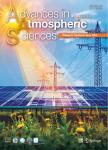Regime Shifts in the North Pacific Simulated by a COADS-driven Isopycnal Model
Regime Shifts in the North Pacific Simulated by a COADS-driven Isopycnal Model作者机构:LEDSouth China Sea Institute of OceanologyChinese Academy of SciencesGuangzhou510301 Guangzhou Institute of Tropical Ocean and MeterologyCMAGuangzhou510080 International Arctic Research CenterUniversity of Alaska FairbanksAlaska 99775-7340USA Department of Atmospheric and Oceanic SciencesUniversity fo Wsiconsin-MadisonWisconsin 53706-1695USA
出 版 物:《Advances in Atmospheric Sciences》 (大气科学进展(英文版))
年 卷 期:2003年第20卷第5期
页 面:743-754页
核心收录:
学科分类:07[理学] 0707[理学-海洋科学] 0706[理学-大气科学] 0816[工学-测绘科学与技术] 0825[工学-航空宇航科学与技术]
基 金:supported by the IARC-Frontier Research System for Global Change the National Natural Science Foundation of China(40136010) the Chinese Academy of Sciences(KZCX2-205 and KZCX2-203)
主 题:North Pacific ventilated thermocline regime shift isopycnal model
摘 要:The Miami Isopycnal Coordinate Ocean Model (MICOM) is adopted to simulate the intevdecadal variability in the Pacific Ocean with most emphasis on regime shifts in the North Pacific. The computational domain covers 60°N to 40°S with an enclosed boundary condition for momentum flux, whereas there are thermohalirie fluxes across the southern end as a restoring term. In addition, sea surface salinity of the model relaxes to the climatological season cycle, which results in climatological fresh water fluxes. Surface forcing functions from January 1945 through December 1998 are derived from the Comprehensive Ocean and Atmospheric Data Set (COADS). Such a numerical experiment reproduces the observed evolution of the interdecadal variability in the heat content over the upper 400-m layer by a two-year lag. Subduction that occurs at the ventilated thermocline in the central North Pacific is also been simulated and the subducted signals propagate from 35°N to 25°N, taking about 8 to 10 years, in agreement with the expendable Bathy Thermograph observation over recent decades. Interdecadal signals take a southwest-ward and downward path rather than westward propagation, meaning they are less associated with the baroclinic planetary waves. During travel, the signals appear to conserve potential vorticity. Therefore, the ventilated thermocline and related subduction are probably the fundamental physics for interdecadal variability in the mid-latitude subtropics of the North Pacific.



